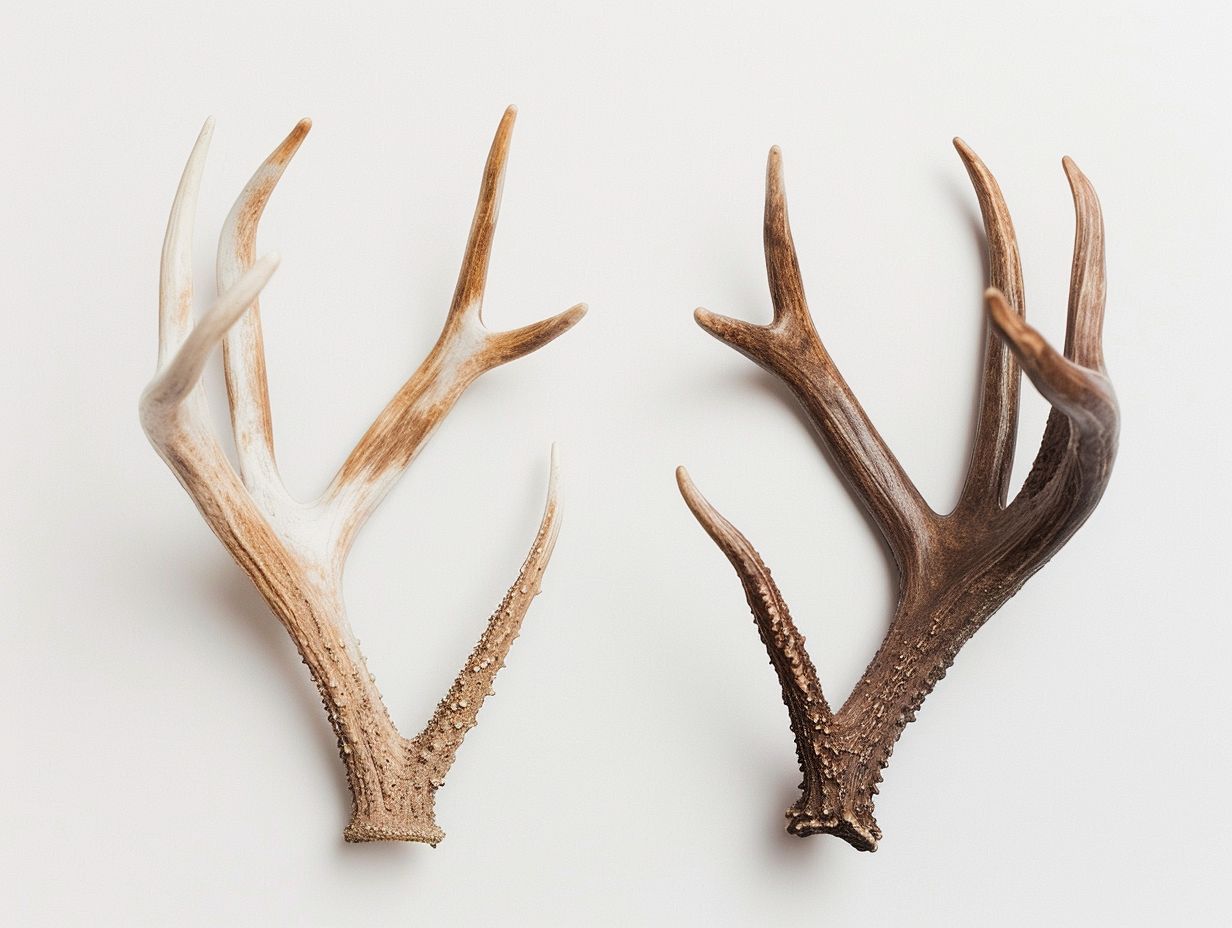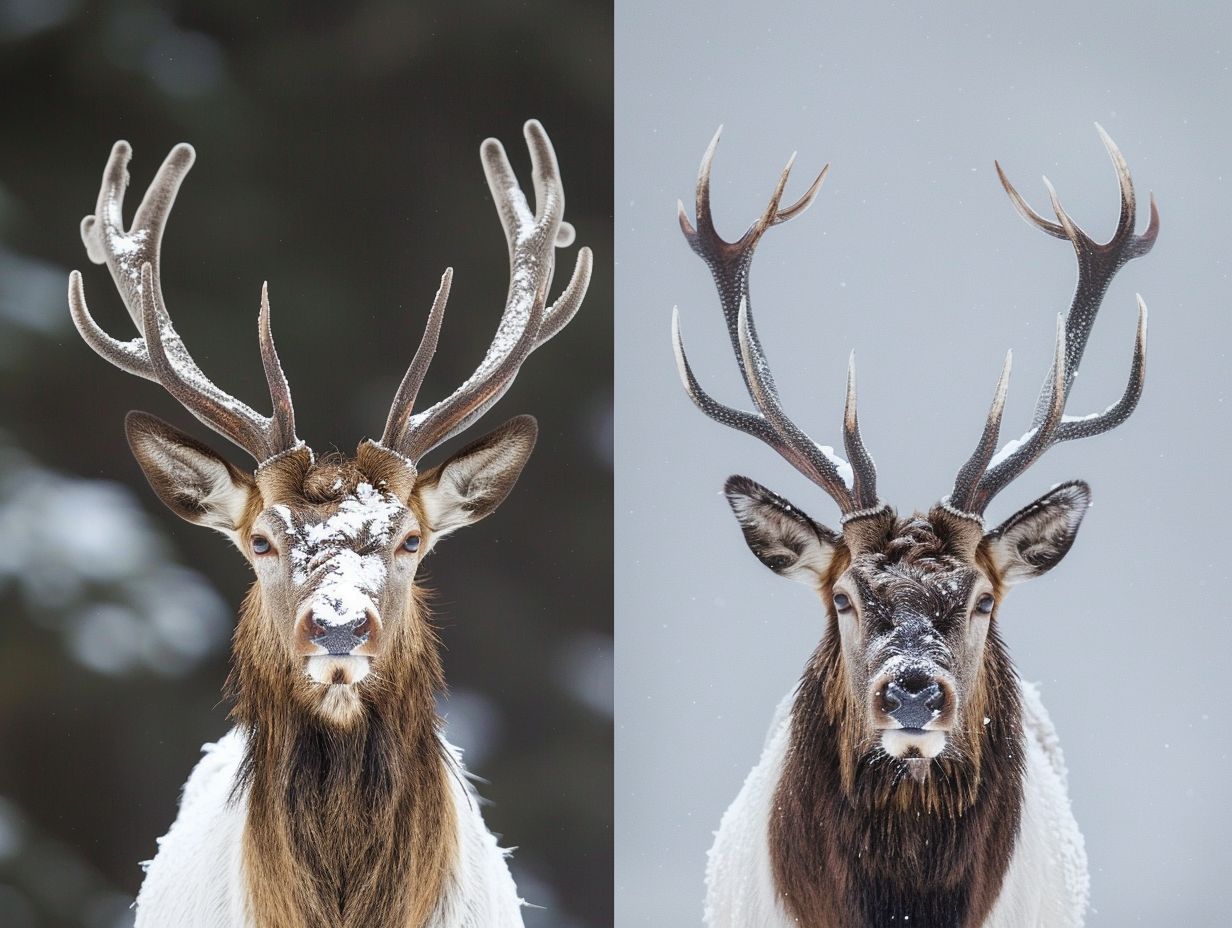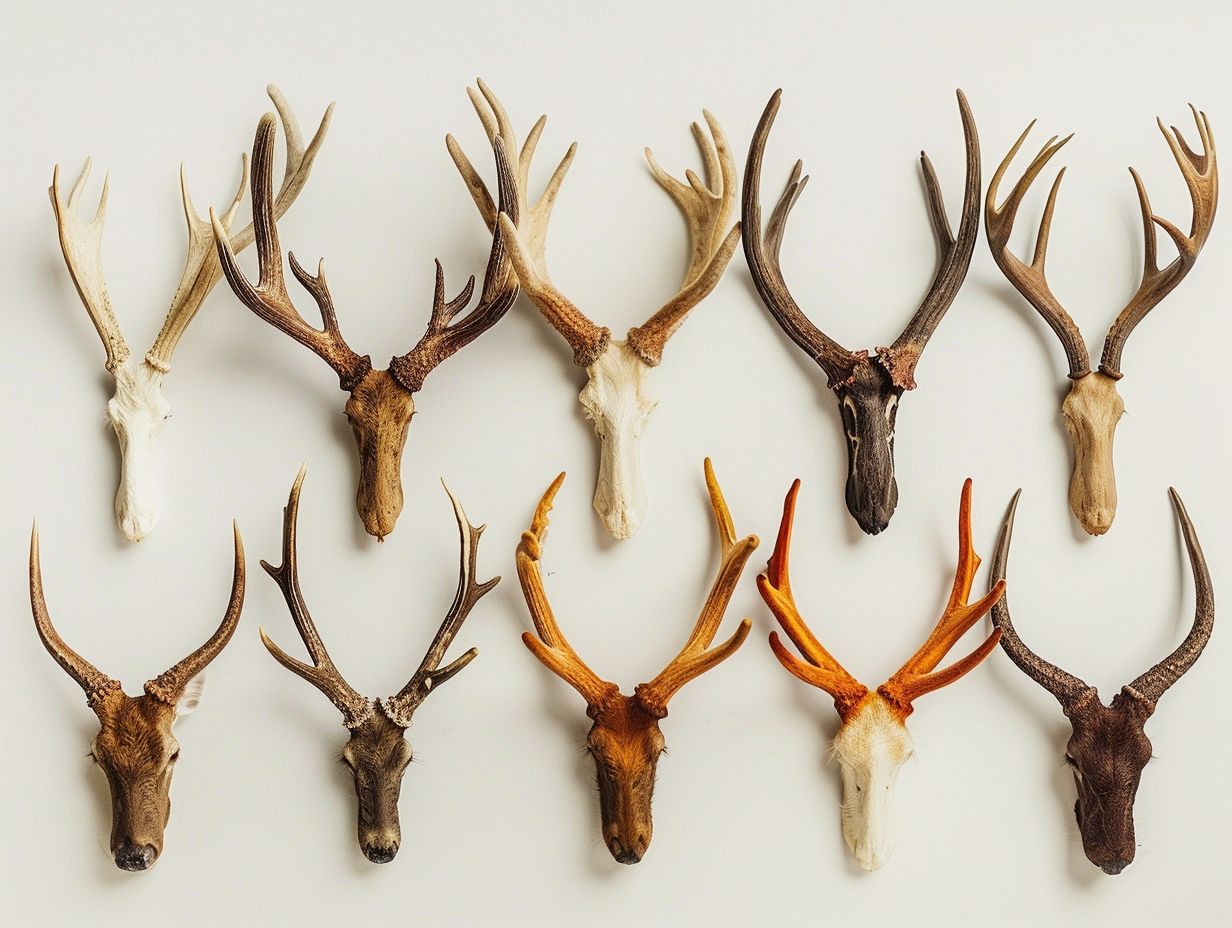Deer Antler Velvet Vs Elk Antler Velvet

Antler velvet, a unique natural substance, has long been used for its nutritional and potential health benefits.
We will explore the differences between deer antler velvet and elk antler velvet, their traditional and modern uses, nutritional benefits, potential health advantages, as well as any risks or side effects associated with their use.
Discover the fascinating world of antler velvet.
Key Takeaways:

- Deer antler velvet and elk antler velvet are both natural supplements derived from antlers of different animals.
- While deer antler velvet has been traditionally used for its medicinal properties, elk antler velvet has gained popularity in modern times for its potential benefits in improving athletic performance and joint health.
- Both deer antler velvet and elk antler velvet contain a variety of nutrients and have potential risks associated with their use, so it is important to consult with a healthcare professional before taking them as a supplement.
What is Antler Velvet?
Antler velvet is a unique substance that is grown and shed annually by various species of deer, including elk, reindeer, mule, white tail, red, and fallow deer. It is known for its regenerative properties and is harvested for medicinal and nutritional purposes.
The growth process of antler velvet starts with the rapid regeneration of tissue, rich in blood vessels, nerves, and cartilage, which forms the basis of the antlers. As the antlers grow, a soft layer of velvet covers them, providing nutrients and support for the developing bone structure.
This velvet stage is a crucial phase in antler development, as it contains growth factors and hormones. It is fascinating to observe how different deer species adapt to varied habitats to sustain the growth of their antlers.
What is Deer Antler Velvet?
Deer antler velvet is a prominent natural supplement derived from the antlers of Cervidae family species, such as Cervus Canadensis found in North America. It has been traditionally used in various treatments, including osteoarthritis and rheumatoid arthritis, and is a key component in traditional Chinese medicine.
The harvesting process of deer antler velvet involves careful, humane extraction of the soft, cartilaginous tissue before it calcifies into hard antlers. This typically occurs in the early stages of antler growth when the velvet is rich in nutrients and bioactive compounds.
Historically, deer antler velvet has been esteemed for its healing properties in Asian cultures, dating back to ancient times. The velvet is rich in growth factors, amino acids, and minerals like calcium and phosphorus, making it beneficial for overall health and wellness.
What is Elk Antler Velvet?
Elk antler velvet, sourced from species like Cervus elaphus found in East Asia, is prized for its pharmaceutical potential and use in supplements. Research has been conducted to determine its effectiveness, safety profiles, and potential interactions with other medications.
Regarding the collection of elk antler velvet, it involves a meticulous process that focuses on the humane extraction of the soft velvety tissue from elk antlers during the phase of rapid growth. This is crucial to ensure the quality and potency of the velvet.
Once harvested, the velvet undergoes a series of processing methods, including drying, grinding, and filtration to extract the bioactive compounds with therapeutic properties.
In pharmaceuticals, elk antler velvet has shown promise in various applications ranging from anti-inflammatory to immunomodulatory effects. It contains valuable components like IGF-1, collagen, and amino acids, which contribute to its health benefits.
Ongoing research continues to explore its potential benefits, such as promoting bone health, enhancing athletic performance, and supporting overall well-being. Studies also examine potential side effects like allergic reactions or interactions with certain medications, highlighting the importance of further investigations to ensure its safety and efficacy.
How is Antler Velvet Collected?
The collection of antler velvet involves careful extraction from elk herds under the supervision of veterinarians. The process typically includes the use of articaine hydrochloride for local anesthesia, ensuring a safe and humane removal of the velvet from species like red deer.
Regarding other deer species such as fallow deer, the extraction process may require slight modifications based on their anatomy and behavioral characteristics. Veterinarians play a crucial role in not only overseeing the extraction but also in determining the appropriate dosage of anesthesia to minimize discomfort for the animals.
What is the Process of Collecting Deer Antler Velvet?
The collection of deer antler velvet involves removing the velvet from the antler base after assessing the health of the deer. This process may include the administration of health assessment questionnaires, visual analog scales (VAS), and the use of natural supplements like Angelica gigas or KGC-HJ3.
Health assessments are crucial in determining the suitability of the deer for velvet extraction, ensuring that the process is ethical and safe. Questionnaires help gather vital information about the deer’s health history, while visual analog scales aid in quantifying pain or discomfort levels.
The natural supplements such as Angelica gigas and KGC-HJ3 play a significant role in providing necessary nutrients to the deer during the velvet collection process, promoting overall well-being and supporting antler growth.
What is the Process of Collecting Elk Antler Velvet?
The process of collecting elk antler velvet involves meticulous extraction techniques to preserve the integrity of the antler bone structure.
Studies published in Naunyn-Schmiedeberg’s Archives of Pharmacology delve into the histomorphology of antlers, shedding light on the intricate composition of antler supplements.
The unique properties of velvet antler, such as its rich source of growth factors and chondroitin sulfate, have been of interest to researchers exploring the potential health benefits it may offer.
Understanding the structural integrity of elk antler velvet is crucial in maintaining its therapeutic properties when used in traditional medicine and as a dietary supplement.
What are the Uses of Antler Velvet?

Antler velvet has a rich history of traditional uses in various cultures and has seen advancements in modern pharmaceutical applications. It is widely utilized in treating conditions like osteoarthritis and rheumatoid arthritis, with products like Cervusen® derived from species such as Cervus nippon.
Historically, antler velvet has been revered for its healing properties, dating back centuries in Eastern medicine where it was treasured for its ability to boost vitality and strengthen the body.
Today, with advancements in pharmaceutical research, this natural substance has garnered attention for its potential to alleviate joint pain and inflammation, offering alternative therapies for those suffering from debilitating conditions.
The development of products like Cervusen® signifies a merging of tradition and modern innovation, bringing the benefits of antler velvet to a wider audience seeking natural remedies for various health issues.
Through careful extraction and processing techniques, manufacturers have been able to create supplements that harness its therapeutic properties effectively.
What are the Traditional Uses of Deer Antler Velvet?
Deer antler velvet has been traditionally employed for various health purposes, with formulations like Cervusen® 2 x 350mg gaining popularity. It has been historically linked to improving health assessments using tools like the Arthritis Impact Measurement Scale 2 (AIMS2).
Historically, indigenous cultures across Asia have used deer antler velvet for its potent health benefits. The unique bioactive compounds in Cervusen® have garnered attention for their potential in supporting joint health and overall vitality.
AIMS2, a standardized assessment tool, has indicated positive outcomes in mobility, pain management, and quality of life for individuals incorporating deer antler velvet supplements into their wellness regimens.
What are the Modern Uses of Elk Antler Velvet?
Modern applications of elk antler velvet span various industries, from pharmaceutical supplements to hormone treatments. Clinical trials have been conducted to assess its efficacy in different treatments and its potential impact on hormone-sensitive conditions.
Given its rich source of growth factors and IGF-1, elk antler velvet has shown promise in potentially aiding in muscle recovery, joint health, and overall wellness.
In recent years, researchers have been exploring its benefits in sports medicine, particularly for improving athletic performance and reducing recovery time. Ongoing studies are diving into its role in addressing specific health conditions such as osteoarthritis and osteoporosis, offering hope for innovative treatment approaches.
What are the Nutritional Benefits of Antler Velvet?
Antler velvet offers various nutritional benefits, including calcium content and D-galactose, crucial for calcium absorption. Studies on fallow deer antler velvet have shown promising results in addressing conditions like osteoporosis through peptide-calcium chelate formulations.
Calcium plays a vital role in bone health, aiding in bone structure and density. The unique properties of antler velvet make it a valuable source of bioavailable calcium, enhancing the body’s ability to absorb and utilize this essential mineral.
Research indicates that the combination of peptides and calcium in antler velvet may have a synergistic effect, potentially increasing the efficacy of calcium supplementation in supporting bone strength.
Specific deer species, such as red deer, have also been studied for their antler velvet’s nutrient composition, showing variations in calcium levels and bioavailability.
What Nutrients are Found in Deer Antler Velvet?
Deer antler velvet is rich in essential nutrients and bioactive substances, as evidenced by biological research. The unique composition of peptide-calcium chelate found in antlers, particularly from red deer, contributes to its nutritional value and potential health benefits.
Deer antler velvet is known to contain a variety of essential nutrients such as proteins, minerals, and growth factors, making it a valuable natural supplement. These bioactive components have been studied for their potential role in promoting joint health, muscle strength, and overall vitality.
Research has shown that the peptide-calcium chelate in deer antler velvet may aid in bone formation and density, as well as supporting connective tissue health. The extraction process of this key substance involves careful processing to preserve its bioavailability and efficacy.
When considering the nutritional impact of antler removal from species like red deer, it is important to acknowledge the role that antlers play in the animal’s overall well-being and ecosystem balance.
What Nutrients are Found in Elk Antler Velvet?
Elk antler velvet boasts a diverse nutrient profile, encompassing various bioactive substances and flavors.
Research on the chemical composition of elk antler velvet, particularly from Korean sources or imported varieties, has revealed a complex interplay of proteins, minerals, and growth factors. These components contribute to its unique taste profiles and potential health benefits.
Elk antler velvet is rich in collagen, amino acids, chondroitin sulfate, and glucosamine, making it a valuable supplement for joint health and athletic performance. Understanding the bioactive compounds present in elk antler velvet is crucial for its application in food science and animal resources.
What are the Potential Health Benefits of Antler Velvet?
Antler velvet shows promise in providing a range of health benefits, from pharmaceutical advancements in treating conditions like osteoarthritis to potential enhancements in sexual function and sporting performance. Clinical trials utilizing tools like the Jadad scale have explored its effects and interactions with other drugs.
Researchers are particularly intrigued by the potential of antler velvet to alleviate joint pain and inflammation effectively. Studies have suggested that it may have a positive impact on libido and fertility. Athletes are also exploring its use due to anecdotal evidence of increased endurance and strength.
Ongoing trials are delving deeper into the mechanisms through which antler velvet exerts its effects, hoping to uncover its full potential in various health applications. Discussions on potential drug interactions with antler velvet are gaining attention within the medical community.
Can Antler Velvet Improve Athletic Performance?

Research trials have investigated whether antler velvet supplements can enhance athletic performance. The studies have analyzed the quality of the supplements, their manufacturing processes, and the potential benefits for athletes.
One notable aspect of these trials is the focus on the various methodologies employed to assess the efficacy of antler velvet supplements. Researchers have conducted randomized controlled trials, double-blind studies, and cross-over experiments to gather comprehensive data on the impact of these supplements on physical performance.
The emphasis on quality assurance in the processing and manufacturing of antler velvet supplements is crucial. Manufacturers adhere to strict standards to ensure the purity and potency of the final products, underscoring the importance of delivering safe and effective supplements to athletes seeking performance enhancement.
Can Antler Velvet Help with Joint Health?
Antler velvet has been explored for its potential in improving joint health, particularly in addressing arthritis and hormone-sensitive conditions. Research suggests its positive impact on conditions like breast cancer, uterine cancer, and ovarian cancer.
Antler velvet, derived from the antlers of growing deer, contains various beneficial compounds such as collagen, glucosamine, chondroitin, and growth factors. These components play a crucial role in supporting joint function and reducing inflammation, which are essential factors in managing arthritis.
Studies have indicated that antler velvet may help regulate hormone levels, potentially aiding in hormone-sensitive diseases. The bioactive substances within antler velvet can interact with hormonal pathways, offering a promising avenue for treatment and symptom management in conditions like breast cancer, uterine cancer, and ovarian cancer.
Can Antler Velvet Boost Immune System?
Antler velvet has been studied for its potential to bolster the immune system and combat various diseases. It shows promise in hormone treatments and addressing drug residues, indicating its potential in supporting overall immune health.
Research has shown that antler velvet contains a variety of bioactive compounds that can stimulate the immune response, potentially aiding in the body’s ability to fight off infections. The presence of growth factors in antler velvet may have implications for hormone therapies, offering a natural alternative for hormone-related conditions.
Antler velvet also holds promise in the detoxification process, helping to eliminate drug residues from the body and reduce toxic overload that could compromise immune function. It is important to note that while antler velvet has shown potential benefits, there are still risks associated with its use, particularly in terms of purity and quality control to avoid contamination with harmful substances.
Can Antler Velvet Improve Sexual Health?
Studies suggest that antler velvet may have positive effects on sexual health and function. Its impact on hormone-sensitive conditions and treatments indicates a potential link between antler velvet and sexual well-being.
Antler velvet, derived from the inner core of growing deer, elk, and moose antlers, contains a rich source of growth factors, amino acids, and essential nutrients. These components are believed to support hormonal balance, potentially enhancing libido and overall sexual performance.
Moreover, antler velvet has been associated with increased energy levels, stamina, and muscle strength, all of which can contribute to improved sexual experiences. The presence of IGF-1 (Insulin-like Growth Factor 1) in antler velvet has been linked to cell growth and regeneration, which may positively impact reproductive health as well.
Are There Any Risks or Side Effects of Using Antler Velvet?
While antler velvet offers potential health benefits, it is essential to understand the risks and potential side effects associated with its use. Individuals with conditions like arthritis, hormone-sensitive diseases, and cancers such as breast, uterine, or ovarian cancer should be cautious about using antler velvet.
Antler velvet supplementation may pose risks of drug interactions, particularly with medications that affect blood clotting or immune function. It can also exacerbate certain health conditions, such as worsening arthritis symptoms or increasing estrogen levels in hormone-sensitive diseases like breast cancer.
For individuals with hormone-sensitive cancers, the estrogen-like compounds in antler velvet could potentially promote tumor growth, making it important to consult a healthcare provider before incorporating it into their regimen.
What are the Potential Risks of Using Deer Antler Velvet?
Deer antler velvet may pose risks in terms of side effects and potential drug residues that could impact individuals with conditions like arthritis, hormone-sensitive diseases, and breast cancer. Careful consideration and consultation with healthcare providers are advised before its usage.
Some potential side effects of deer antler velvet consumption include digestive issues, dizziness, and allergic reactions.
There is a concern regarding residual drugs present in the velvet, which could interact unfavorably with existing medication or exacerbate certain conditions.
For individuals with arthritis, the potential impact of deer antler velvet on inflammation levels and joint health should be carefully monitored.
What are the Potential Risks of Using Elk Antler Velvet?
Elk antler velvet usage may carry risks in terms of side effects, interactions with other substances, and implications for diseases like hormone-sensitive conditions, uterine cancer, and ovarian cancer. Individuals considering elk antler velvet supplementation should be aware of these potential risks.
Some common side effects of elk antler velvet consumption include stomach discomfort, nausea, dizziness, and insomnia.
Due to its potential interactions with medications, it’s crucial to consult with a healthcare provider before incorporating it into your routine, especially if you are taking blood thinners or medications that affect hormone levels.
For individuals with hormone-sensitive conditions like breast cancer, using elk antler velvet may exacerbate hormonal imbalances, making it essential to avoid its consumption.
Frequently Asked Questions

What is the difference between Deer Antler Velvet and Elk Antler Velvet?
Deer Antler Velvet and Elk Antler Velvet are both derived from the antler tissue of different species of deer. While they are similar in many ways, there are some key differences between the two.
Which animal is Deer Antler Velvet extracted from?
Deer Antler Velvet is extracted from the antlers of various species of deer, including red deer, elk, and moose. It is most commonly harvested from red deer, which are found in Asia, Europe, and New Zealand.
Which animal is Elk Antler Velvet derived from?
Elk Antler Velvet is derived from the antlers of elk (also known as wapiti), which are found in North America and parts of Asia. Elk antlers are typically larger and more robust than those of deer, making them a popular choice for antler velvet supplements.
Is there a difference in the nutritional content of Deer Antler Velvet and Elk Antler Velvet?
While both Deer Antler Velvet and Elk Antler Velvet contain similar nutrients and compounds, there may be variations in their specific concentrations. Factors such as the age, health, and diet of the animal can affect the nutritional content of their antler velvet.
Which type of antler velvet is considered more potent or effective?
It is difficult to determine which type of antler velvet is more potent or effective, as there is limited scientific research comparing the two. However, some people believe that Elk Antler Velvet may be more potent due to its larger size and more robust antlers.
Are there any notable differences in the uses or benefits of Deer Antler Velvet and Elk Antler Velvet?
Both Deer Antler Velvet and Elk Antler Velvet have been used in traditional medicine and as dietary supplements for various purposes. While they share some similar benefits, such as promoting joint health and boosting athletic performance, there may be slight differences in the specific benefits of each type of antler velvet.